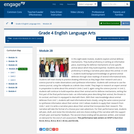
In this eight-week module, students explore animal defense mechanisms. They build proficiency in writing an informative piece, examining the defense mechanisms of one specific animal about which they build expertise. Students also build proficiency in writing a narrative piece about this animal. In Unit 1, students build background knowledge on general animal defenses through close readings of several informational texts. Students will read closely to practice drawing inferences as they begin their research and use a science journal to make observations and synthesize information. Students will continue to use the science journal, using the millipede as a whole class model. They begin to research an expert animal in preparation to write about this animal in Units 2 and 3, again using the science journal. In Unit 2, students will continue to build expertise about their animal and its defense mechanisms, writing the first part of the final performance task—an informative piece describing their animal, the threats to its survival, and how it is equipped to deal with them. With their new knowledge about animal defenses from Unit 1, students will read informational texts closely, using the same science journal to synthesize information about their animal. Unit 3 allows students to apply their research from Units 1 and 2 to write a narrative piece about their animal that incorporates their research. This narrative will take the format of a choose-your-own-adventure. For their performance task, students will plan, draft, and revise the introduction and one choice ending of the narrative with the support of both peer and teacher feedback. The second choice ending will be planned, written, and revised on-demand for the end of unit assessment.
Find the rest of the EngageNY ELA resources at https://archive.org/details/engageny-ela-archive .
- Subject:
- English Language Arts
- Reading Informational Text
- Material Type:
- Module
- Provider:
- New York State Education Department
- Provider Set:
- EngageNY
- Date Added:
- 02/02/2014
